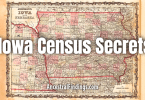The 1890 U.S. Census is one of the most heartbreaking gaps in American records. It leaves a missing chapter for family historians—twenty years between 1880 and 1900 when so much changed. Children grew up and left home, elders passed on, families relocated, and new generations were born. But the record meant to capture it all is mostly gone. The story of how we lost the 1890 census and how we’ve learned to work around it still has much to teach us.
A Census Unlike Any Before
The 1890 census was designed to be more detailed than anything the federal government had attempted up to that point. It was meant to reflect a nation charging forward into modern life. Enumerators were instructed to gather complete household listings—names, ages, occupations, relationships, races, birthplaces, marital status, literacy, employment, and housing information, including whether a family had access to running water or a telephone.
Special schedules were also created for Union Civil War veterans and their widows. These records were a treasure in their own right, containing military service details, length of service, injuries, and sometimes information about pensions or family members.
If the 1890 census had survived, we’d have had an extraordinary look at families at the dawn of the electric age, on the edge of the 20th century. But that window was closed in a single devastating event.
The Fire That Took a Generation
In January 1921, the census records were being stored in the basement of the Commerce Department in Washington, D.C., when a fire broke out. Water damage from firefighting efforts, followed by inaction and poor preservation decisions, led to the loss of nearly the entire 1890 population schedule.
A few fragments were saved—portions of records from just over 6,000 individuals in a handful of counties across ten states. But the vast majority of the census was destroyed, and in the years that followed, even damaged and salvageable sections were discarded without proper review. It was a staggering archival loss, not just for genealogists but for American history as a whole.
The Impact on Family History Research
The loss of the 1890 census created a significant research gap. For many families, this means we have no direct federal snapshot between 1880 and 1900. That’s twenty crucial years of migration, marriage, death, remarriage, land changes, and movement westward—all without a federal paper trail.
This is especially challenging for those tracing immigrant ancestors who may have arrived during that window or for African American families navigating the post-Reconstruction years. In many cases, a person who appears as a child in 1880 reappears in 1900 with a new spouse, in a new county, and with missing parents or siblings. Without the 1890 census, we have to bridge that gap with every other tool available.
What Survives: The Veterans Schedule
Thankfully, some records were spared. One of the most useful surviving resources is the 1890 Veterans Schedule, which includes listings of Union veterans and their widows from many states. It notes the veteran’s name, rank, regiment, years of service, address, and any war-related injuries or conditions.
For Civil War researchers, this schedule is invaluable. Even if a family’s 1890 population record is gone, a veteran’s listing can help you locate their residence, identify widows or heirs, and even provide medical or financial information that can be followed into pension records.
State Censuses That Fill the Gap
Several states conducted their own censuses in the late 1880s and early 1890s. These state records have become a lifeline for those trying to track a family through the missing federal years.
Iowa conducted state censuses in 1885 and 1895. Minnesota and South Dakota also conducted censuses in 1895. New York held one in 1892, and New Jersey followed in 1895. Florida and Colorado both conducted state censuses in 1885. If your ancestor lived in one of these states, it’s worth digging into their records—many include names, ages, occupations, and places of birth.
City Directories as a Substitute Census
City directories, published year by year, function like early phone books—except they existed before phones were common. They list the names of heads of households, addresses, and occupations. Some even include business listings or spousal names.
If your ancestor lived in a town or city, these directories can be used to track them over time. They may not show family structure, but they offer continuity—especially when combined with land records or newspaper mentions.
Land, Tax, and Legal Clues
Local land records can reveal who bought or sold property during the missing years. These documents might list heirs, neighbors, or witnesses who help confirm identities. Tax rolls can show who lived in a particular township and owned land or livestock. And legal records—like probate files or guardianship proceedings—can reveal a surprising amount of detail.
A person who disappears from the census might reappear in a land deed or court proceeding. A young orphan might show up in guardianship papers or church-supported boarding arrangements. These types of records are scattered but powerful.
Newspapers That Fill in the Story
The 1880s and 1890s were a golden era for local newspapers. Small-town papers often printed everything: school announcements, court dockets, family reunions, church socials, land auctions, and detailed obituaries. In the absence of a census, newspapers can tell us where someone lived, what they did, and who they knew.
When I couldn’t find a branch of my family in any record between 1880 and 1900, a newspaper clipping told me they had moved to Missouri for work. That one article filled in a decade of their story.
Church and School Records
Church registers for baptisms, marriages, and burials often continued uninterrupted during the 1890 gap. In rural areas, these may be the most reliable records available. And if children were in school, rosters or teacher’s ledgers may survive. Early yearbooks and academy attendance lists can sometimes substitute for the census in showing who lived where and when.
Pension Files and Veterans’ Traces
Civil War pension applications—especially those filed or updated in the 1880s and 1890s—can act as family histories all their own. These files sometimes contain dozens of pages, including affidavits, letters, birth records, marriage certificates, and testimony from friends or neighbors. Widows had to prove their marriages, which often led to additional details being recorded that aren’t available anywhere else.
Fragments That Still Exist
While most of the 1890 census was destroyed, a few fragments do survive. These include small parts of Alabama, Georgia, Illinois, Minnesota, New Jersey, New York, North Carolina, Ohio, South Dakota, Texas, and the District of Columbia. Though limited, these records are fully digitized and searchable online. If your ancestor happened to live in one of these surviving areas, you may be among the lucky few.
Final Thoughts
The 1890 census was supposed to give us a glimpse into a fast-changing America full of growing cities, rising industries, and a generation coming into its own. Instead, its destruction became one of the most significant losses in historical and genealogical research. But we’re not left without hope. We can still find our ancestors in that missing decade by using veterans’ schedules, state censuses, city directories, newspapers, land deeds, and pension files.
And maybe—maybe—the extra digging we do to get around that missing record leads us to even more than we would’ve found otherwise. It teaches us to think like detectives, to explore the records others overlook, and to listen for the stories still being told in old ledgers, dusty directories, and forgotten newspapers.
So, while the 1890 census may be gone, your ancestors aren’t. They left footprints—and you can still follow them.






